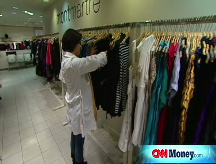Holiday sales: Losers and winners
Except for Wal-Mart, and some high-fashion brand sellers, analysts say the year-end shopping period was a lost cause for merchants.
NEW YORK (CNNMoney.com) -- For most merchants, the 2008 holiday shopping season couldn't be over fast enough.
Retailers have struggled with slumping sales all year and the situation worsened as the economy weakened further heading into the fourth quarter.
Given the accelerating job losses ahead of Christmas, there was also little hope of sellers getting a last-minute boost from the gift-buying frenzy that typically occurs in November and December.
Those two months can account for as much as half of merchants' annual profits and sales.
So with the deck stacked against them, just how bad was the final sales push for retailers?
We'll know for certain next week when leading national store chains such as Wal-Mart, Macy's (M, Fortune 500) and Gap Inc. (GPS, Fortune 500) report their December same-store sales.
Same-store sales measure sales at stores open at least a year.
But already the forecasts look bleak.
Sales tracker Thomson Reuters expects December same-store sales for the 34 retailers it tracks will have dropped 1% for the month. That would be weaker than the 0.5% gain logged a year ago.
To mention just a few, department store chains J.C. Penney (JCP, Fortune 500) and high-end sellers Nordstrom and Saks are forecast to report double-digit percentage drops for their December same-store sales.
Although sellers slashed clothing prices by as much as 80% to lift pre-Christmas store traffic and sales, it still wasn't enough to draw out reluctant shoppers.
Two of the biggest casualties in the clothing space, according to Thomson Reuters, will be women's clothing chain Chico's and teen-oriented chain Abercrombie & Fitch.
In a note Monday, Pali Research analyst Amy Wilcox Noblin said customer traffic to Abercrombie & Fitch stores and its sister store Hollister was "weak" ahead of Christmas.
"Regardless of traffic, both divisions still have substantial inventory to work through given the poor pre-Christmas sales and we believe that it will be hard for it to make up ground at this stage with the tapped out consumer and steep discounts elsewhere in the mall," said Noblin, who has a "sell" rating on Abercrombie & Fitch.
Eric Beder, retail analyst with Brean Murray, Carret & Co., said finding retail winners in this environment will be a challenge but he did manage to uncover some holiday winners.
"We're looking at companies who still have lots of cash and have reduced their inventory as opposed to those with the best holiday sales," Beder said.
Based on that criteria, Beder expects premium denim seller True Religion to emerge a holiday "winner."
And he said women's fashion seller Bebe (BEBE) has "continued to be aggressive in clearing out goods [and] virtually all categories have seen some type of discount in the holiday season."
Beder picked high-fashion clothing seller, "GUESS?, as another winner saying that the retailer has reduced its seasonal inventory over the holiday season as it "continues to do what is necessary to become [lean on inventory] for the first quarter."
"Having appealing merchandise is important," he said. "Consumer spending hasn't died, consumers are just spending less. So the winners are also whoever is taking more market share amid smaller levels of purchases."
One obvious holiday winner is Wal-Mart, according to Beder. Thomson Reuters estimates the world's largest retailer to log a 2.8% same-store sales gain in December, in-line with the company's own forecast for a 1% to 3% sales increase.
Wal-Mart (WMT, Fortune 500) has gained market share in a recessionary environment as more consumers trade down to its low prices for their everyday purchases.
Beder believes it's that trend more than anything else that is benefiting Wal-Mart's sales.
"Wal-Mart isn't doing anything exciting. Their [same-store] sales increases are still much softer than where they used to be," he said, alluding to the retailer's same-store sales gains of 6% and higher in the mid 1990s.
But if Wal-Mart ends the year with less unsold merchandise, that will position it to emerge a winner in the New Year, he said.
"The question becomes who is in the best position to take advantage if the consumer does comes back in 2009," he said. "I think it's retailers who have low inventory and are financially stable."
Wal-Mart rival Target has struggled with slowing store sales as its higher-income shoppers shifted some of their purchases to lower-priced discounters including Wal-Mart.
But Marshal Cohen, chief analyst with NPD Group, thinks 2009 could bring a turnaround for Target's sales.
"There's a lot of pent-up demand among consumers," Cohen said. He's betting that many Americans will eventually start to get bored with being deliberately frugal and start to trade up again in price and quality of products.
"Target is in a perfect place to benefit from this," he said. "It could gain market share both from low-income consumers trading up and higher-income [consumers] who still want to trade down but not to Wal-Mart."
"I see Target as a longer-term winner," he added. ![]()


